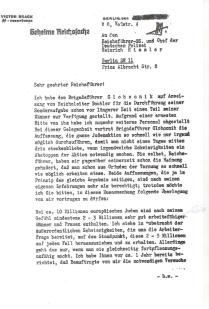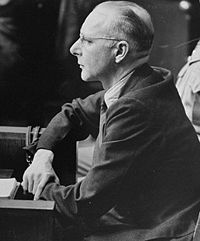Holocaust Education & Archive Research Team |
|
Euthanasia
Nazi Eugenics & Euthanasia T- 4 Staff T- 4 in Poland T - 4 in Germany & Austria | |||
Victor Brack
T4 - Euthanasia and Links to Mass Murder in the East
Victor Brack was born in Haaren, Germany on the 9 November 1904 the son of a medical practitioner. After studying economics in Munich he became a fiend of Heinich Himmler and for a time he became a chauffeur for the future Reichsfuhrer-SS. Brack then became a member of the NSDAP and the SS in 1929.
Throughout his career in the Party he was quite active in high official circles. He entered upon full-time service in the Braune Haus, the Nazi headquarters at Munich, in the summer of 1932.
Brack was promoted to the rank of Sturmbannfuehrer in the SS in 1935, and in April 1936 to the rank of Obersturmbannfuehrer. In 1936 he was appointed head liaison officer with the Department of Health by Philip Bouhler, though he had little or no previous medical experience.
Subsequently he rose to become Bouhler’s deputy and Chief of Section II in the Fuhrer’s Chancellery with the rank of Oberdienstleiter. Between December 1939 and August 1941 Brack’s office, known as T-4, from its address at Tiergartenstrasse -4, was responsible during the so-called “Euthanasia Action.”
This programme was responsible for the murder of more than 50,000 Germans, this included the mentally sick, chronically sick and concentration camp prisoners deemed as “unfit for work,” politically undesirable elements and Jews and Gypsies. Brack himself personally interviewed and selected personnel for the euthanasia establishments, from those involved in cremating the corpses, to the cleaners.
Later, because of the urgent need for laborers in Germany, it was decided not to kill Jews who were able to work but, as an alternative, to sterilize them. With this end in view Himmler instructed Brack to inquire of physicians who were engaged in the Euthanasia Program about the possibility of a method of sterilizing persons without the victim's knowledge.
Franz Stangl recalled in an interview with Gitta Sereny, who was about to report for duty in the euthanasia establishment Schloss Hartheim, near Linz:
“I reported to Tiergartenstrasse 4, I think to SS Oberfuhrer Brack who explained what my specific police duties would be.”
In March 1941 he offered the services of his network of institutes to Heinrich Himmler for the purpose of sterilising 3-4000 Jews daily in x-ray clinics.
In August 1941 Karl Brandt telephoned Philip Bouhler to instruct him that on Hitler’s orders the euthanasia programme must be ceased. There was some unease about the murder of invalids and mentally ill Germans. In December 1940 Himmler had recommended to Brack that the euthanasia institute at Grafeneck activities should be suppressed, due to continuing unrest over the euthanasia programme.
Viktor Brack persuaded the Tobis film company to produce the film “Ich Klage an” – I accuse – the sentimental story of a professor who is put on trial for hastening the death of his young wife, an incurable invalid.
Later in 1941 Brack prepared to set up gassing facilities in Riga and Minsk to exterminate Jews, unsuitable for work. Subsequently, he was closely involved in the construction of the death camps in Poland and the installation of gas chambers, and the supply of personnel.
Dr Erhard Wetzel wrote from Rosenberg’s office on the 25 October 1941 to Reichskommissar Lohse in Riga:
“Herr Viktor Brack Oberdienstleiter in the Fuhrer’s Chancellery, is ready to collaborate in the installation of the necessary buildings and gas plants. He thinks it easier to construct the latter, of which we are short, on the spot.
He would like to send his chemist Kallmeyer, to Riga. I request you to communicate with Leiter Brack through your Higher Police Leader, I permit myself to observe that Major Eichmann is in agreement.
From testimony given by a Fre He informs us that the camps are intended for Riga and Minsk where even Jews from the Old Reich may be sent. At the present time Jews who are evacuated from the Old Reich are sent to Lodz and other camps, from which they leave for the East or for labour camps if they are suited.
To judge from the actual situation one need have no scruple in using Brack’s method to liquidate Jews who are unsuitable for work. In this way incidents will no longer be possible or tolerated such as occurred during the shootings at Vilna – and these shootings were public, according to the report that I have before me.
On the other hand, Jews suitable for work will still be sent East to be attached to the Labour Service. Naturally the employable men and women must be separated from each other.”
But Riga and Minsk were discounted for mass gassing facilities; instead the decision was taken to establish the death camps in the General Government. Viktor Brack gave evidence at his trial about the transfer of personnel to “Aktion Reinhard”;
“In 1941 I received an order to discontinue the euthanasia program. In order to retain the personnel that had been relieved of these duties and in order to be able to start a new euthanasia program after the war. Bouhler asked me – I think after a conference with Himmler – to send this personnel to Lublin and place it at the disposal of SS-Brigadefuhrer Globocnik."
The first group of euthanasia personnel, numbering a few dozen men, arrived at Lublin between the end of October and the end of December 1941, included in this contingent were Christian Wirth and Josef Oberhauser who soon went to Belzec death camp.
Viktor Brack visited SSPF Globocnik in Lublin in the beginning of May 1942 and discussed the extermination of Jews and Globocnik requested more personnel as Aktion Reinhard gathered pace.
After this meeting with Globocnik, Viktor Brack wrote to Heinrich Himmler on the 23 June 1942:
Blankenburg, Brack's deputy, replied to Himmler's letter and stated that Brack had been transferred to an SS division, but that he, Blankenburg, as Brack's permanent deputy would "immediately take the necessary measures and get in touch with the chiefs of the main offices of the concentration camps."
More euthanasia personnel arrived in Lublin in May / June 1942, the death camp at Sobibor had just become operational, and Treblinka death camp would follow in July 1942.
nch physician of Jewish descent, who was a prisoner in Auschwitz from September 1943 to January 1945, it can be found that sterilization of Jewish inmates was carried out in Birkenau camp by SS doctors. About 100 male Poles who had been sterilized at Birkenau were attended to by the witness after the operation.
According to the witness, members of the group were later castrated by camp physicians. More evidence was presented, from which it is clear that sterilization using very high doses of X-rays during several minutes was conducted on other persecuted groups. They also were subjected to the excruciatingly painful procedure, and later castrated.
On the 20th August 1947 Brack was sentenced to death at the end of the Doctors’ Trial, by an American military tribunal for his part in the euthanasia programme.
Viktor Brack was hanged in Landsberg prison on the 2 June 1948
Source: Klaus, The Nuremberg Medical Trial, 1946/47, Klaus Dörner Who’s Who in Nazi Germany by Robert S Wistrich, published by Routledge, London 1995 The Final Solution by Gerald Reitlinger, published by Sphere Books London 1971 Into That Darkness by Gitta Sereny, published by Pimlico, London 1974 Wiener Library Nuremberg IMT
Copyright Michael Wembley 2009 H.E.A.R.T
|



